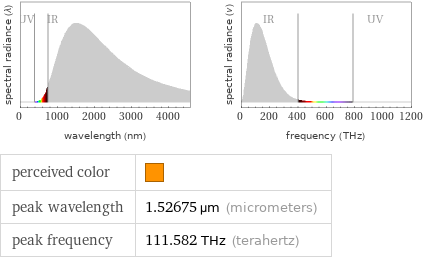Input interpretation

stannic oxide | melting point
Result

1624.85 °C (degrees Celsius)
Unit conversions

1898 K (kelvins)

2956.73 °F (degrees Fahrenheit)

3416.4 °R (degrees Rankine)

1299.88 °Ré (degrees Réaumur)

860.546 °Rø (degrees Rømer)
Comparisons as temperature

43 °C below melting point of titanium (1668 °C)

28 °C above temperature of a Bunsen burner flame (1870 K)

87 °C above melting point of iron (1538 °C)
Blackbody information

perceived color | peak wavelength | 1.52675 µm (micrometers) peak frequency | 111.582 THz (terahertz)
Corresponding quantities

Thermodynamic energy E from E = kT: | 16 ceV (centielectronvolts)

Blackbody energy flux Φ from Φ = σT^4: | 735862 W/m^2 (watts per square meter)

Approximate luminous exitance from a planar blackbody radiator perpendicular to its surface: | 749101 lx (lux)